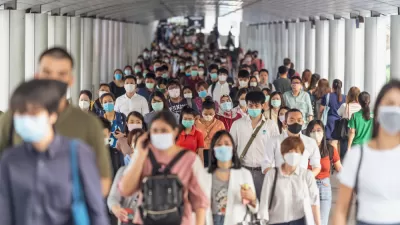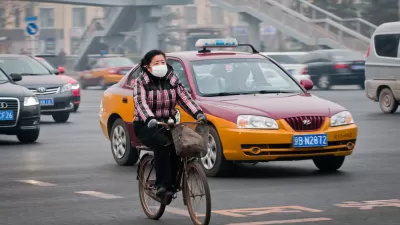Matthew Stevenson anticipates the end of the bicycle in China's major cities, now overrun with scooters and scrambling for Western status symbols – in spite of ever-worsening traffic.
In the midst of their near-overnight metamorphosis, cities in China are struggling to make sense of the tug-of-war between old and new ways of living. Increasingly, the experience of exploring these metropolises by bicycle is deeply emblematic of the older generation's losing battle.
Even just a few years ago, as Stevenson puts it, "Beijing was delightful by bike." But facing cultural pressures for status symbols and luxury, Chinese youth have lost their taste for the humble, utilitarian two-wheeler: "With a single gear and heavy steel frame, the [national standard model] is ideal for long rides on flat city streets. At a cost of US $180, it is the bike bargain of the world. Nevertheless, the dream for younger Chinese is a Honda scooter."
Riding a bicycle in Beijing still comes with certain privileges – dedicated lanes, exclusive rights-of-way, special parking spaces at train stations, and of course the convenience of being able to percolate through gridlocked traffic. But in an environment of ever more unenforceable traffic, cars and scooters encroach further and further on cyclists' territory, making cycling more nerve-wracking than delightful. Stevenson describes his observations during a recent tour through the capital:
"After a while, I had my eyes attuned to the demographics of bike riders. They tended to be school kids or the elderly. From this blacktop survey, I judged that middle-aged or prosperous Beijingers have little appetite for riding. Most were moving around on scooters, the kind that have clogged many Asian cities."
FULL STORY: The Beijing Bicycle: A Requiem

Planetizen Federal Action Tracker
A weekly monitor of how Trump’s orders and actions are impacting planners and planning in America.

Congressman Proposes Bill to Rename DC Metro “Trump Train”
The Make Autorail Great Again Act would withhold federal funding to the system until the Washington Metropolitan Area Transit Authority (WMATA), rebrands as the Washington Metropolitan Authority for Greater Access (WMAGA).

The Simple Legislative Tool Transforming Vacant Downtowns
In California, Michigan and Georgia, an easy win is bringing dollars — and delight — back to city centers.

The Small South Asian Republic Going all in on EVs
Thanks to one simple policy change less than five years ago, 65% of new cars in this Himalayan country are now electric.

DC Backpedals on Bike Lane Protection, Swaps Barriers for Paint
Citing aesthetic concerns, the city is removing the concrete barriers and flexposts that once separated Arizona Avenue cyclists from motor vehicles.

In These Cities, Most New Housing is Under 441 Square Feet
With loosened restrictions on “micro-housing,” tiny units now make up as much as 66% of newly constructed housing.
Urban Design for Planners 1: Software Tools
This six-course series explores essential urban design concepts using open source software and equips planners with the tools they need to participate fully in the urban design process.
Planning for Universal Design
Learn the tools for implementing Universal Design in planning regulations.
Smith Gee Studio
City of Charlotte
City of Camden Redevelopment Agency
City of Astoria
Transportation Research & Education Center (TREC) at Portland State University
US High Speed Rail Association
City of Camden Redevelopment Agency
Municipality of Princeton (NJ)





























